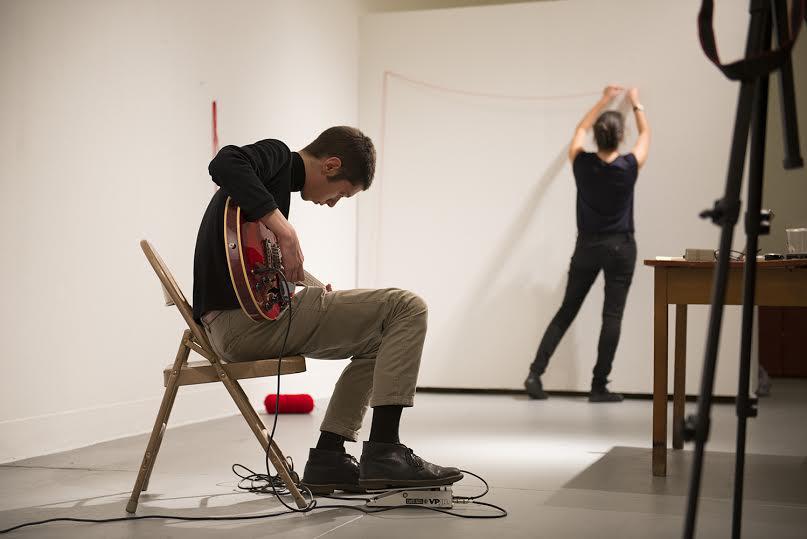Fischer Gallery Hosts Mixed Media Collision
Conservatory junior Sivan Silver-Swartz improvises on electric guitar as College senior Katie Rotman creates an improvised string installation.
November 22, 2013
Last Saturday, SoundFarm, the concert series for improvised music, and Exhibition Initiative, the student-run visual art curatorial group, collaborated to create Counterpoints, a musical and visual improvisational show. The event, which took place in the Fischer Gallery, consisted of four acts. The first three acts were performed by two musicians and one visual artist, while the last act fea-tured one musician and one visual artist. The room was organized such that each act had a preset station, much like an elementary school science fair.
Counterpoints could not have been held in a better location. Fischer Gallery’s towering white walls subtly evoked the anticipation of a blank canvas. This feeling was heightened by the knowledge that the whole space was to come alive to support the performers. The use of Fischer Gallery allowed for an interplay not only between audio and visual art, but also between the creators’ private process and their public performance.
In the first act, keyboardist double-degree sophomore Christy Rose joined double-degree sopho-more Matthew Omahan, who used his computer. The pair were placed on either side of a large canvas. The visual artist, Matthew Gallagher, OC ’13, picked up his paint-covered rubber band tool and prepared to launch, making brief eye contact with the musicians before they began their piece. Watching the performance, one could see the artists thinking, making decisions and listen-ing to each other. One of the best moments of the performance was when the top right corner of the canvas came unattached from the wall. A surprise like that could have sunk a rehearsed show, but the musicians picked up in the temporary absence of the artist. The improvised nature of the show ultimately saved the piece from failing.
The second act, which passed much more slowly, felt like watching an ongoing process rather than a performance. Each artist really took their time, making a move, observing its effect and then deciding whether to proceed or to try a different route. Electric guitarist and Conservatory junior Sivan Silver-Swartz was off to the right, head tilted slightly down, listening and occasion-ally glancing up at the piece unfolding before him. The medium for artist and College senior Ka-tie Rotman was brightly colored red string, which she looped through hooks nailed into the wall. The second musician, College senior Porter James, walked around the space, holding handheld radios playing static. As a whole, they made more complete use of the available space. Like the first act, there were moments that enhanced the experience by taking the audience out of the per-formance: Rotman stopped to eat a carrot, and James caught a classical music station on one of his radios. The artists laughed, and so did the audience.
The third act consisted of devilishly loud electro-punk music performed by double-degree senior Devin Frenze and College senior Dan Friedman and accompanied by the art of College junior Taylor Herman, whose work resembled a mix of Picasso and Van Gogh. Herman’s square piece of plexiglass, suspended from the ceiling by string, swung precariously as he painted furiously to the sound of the music. Half of the audience was hypnotized by the swinging plexiglass, one side of which was painted a vibrant yellow and teal, and the other white and black. The other half of the audience was headbanging along to the music. There was a moment when the artist, en-grossed in his work and swigging from his beer bottle, failed to finish his painting after the music had crescendoed and stopped. Out of respect for the artist’s need to continue, the musicians, barely missing a beat, simply restarted. The energetic piece brilliantly brought together two fairly recognizable genres and created a new piece.
The fourth and final act, a duet, was performed by musician and Conservatory junior Yuri Popowycz and visual artist and College junior Oliver Levine. The piece was set up in such a way that the musician, on electric violin, was in the same position as the audience — facing the artist, whose back was facing the audience, giving the air that the audience was watching over his shoulder. Popowycz was busy constantly recording and looping his performance. Levine’s two canvases, one white and one black, were soon filled by sweeping strokes matched by the violin’s often screeching tones. As one attendee explained, “The artist captured on his canvas in one sec-ond what we heard in three to five minutes of violin loops.”
As a whole, Counterpoints was one of the more creative shows put on by Oberlin students in re-cent memory. Interacting with this performance gave one the sense of watching the future of art unfold. The point of the collaboration between Exhibition Initiative and SoundFarm was not to create something that works, but to create something new. They did a beautiful job; it was in-credible to witness something simultaneously ephemeral and permanent.



















